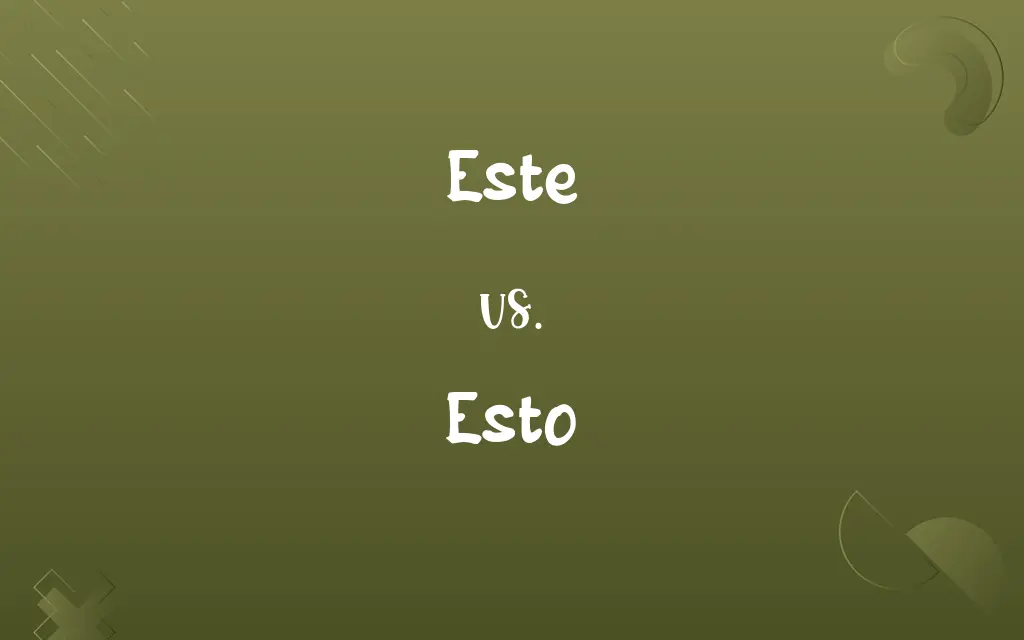Este vs. Esto: Know the Difference

By Shumaila Saeed || Published on February 13, 2024
"Este" is a Spanish demonstrative adjective or pronoun meaning "this" for masculine singular nouns, while "Esto" is a neuter demonstrative pronoun meaning "this" or "this thing."

Key Differences
"Este" is used in Spanish as a demonstrative adjective to describe a masculine singular noun that is close to the speaker, such as "este libro" (this book). "Esto," however, is a neuter pronoun used when the gender of the referred object is unknown or irrelevant, as in "¿Qué es esto?" (What is this?).
Shumaila Saeed
Feb 13, 2024
In grammar, "Este" agrees in gender and number with the noun it modifies, thus only used with masculine singular nouns. In contrast, "Esto" does not change form as it is a neuter pronoun and does not accompany a noun directly.
Shumaila Saeed
Feb 13, 2024
"Este" can also function as a demonstrative pronoun, replacing a noun, as in "Este es mi coche" (This is my car), where it stands for a masculine noun mentioned earlier. "Esto" is used to refer to a situation or abstract idea, as in "Esto es importante" (This is important).
Shumaila Saeed
Feb 13, 2024
When pointing out a specific object or person near the speaker, "Este" is used, emphasizing proximity, like "Este hombre" (this man). "Esto," however, is often used in more general or abstract contexts where the object or concept is not specifically identified.
Shumaila Saeed
Feb 13, 2024
The choice between "Este" and "Esto" depends on the context: "Este" for specific, masculine, singular nouns nearby, and "Esto" for unspecified, abstract, or neutral ideas or objects.
Shumaila Saeed
Feb 13, 2024
ADVERTISEMENT
Comparison Chart
Grammatical Role
Demonstrative adjective or pronoun
Neuter demonstrative pronoun
Shumaila Saeed
Feb 13, 2024
Usage
With specific, masculine singular nouns
For abstract, unspecified ideas or things
Shumaila Saeed
Feb 13, 2024
Function in Sentence
Modifies or replaces a masculine noun
Stands for an unspecified or abstract idea
Shumaila Saeed
Feb 13, 2024
ADVERTISEMENT
Este and Esto Definitions
Este
Used to specify a particular item or person close by.
Este coche es rápido (This car is fast).
Shumaila Saeed
Jan 11, 2024
Esto
Introduces a new idea or subject in a conversation.
Esto te va a interesar (This is going to interest you).
Shumaila Saeed
Jan 11, 2024
Este
Refers to a specific, known entity in a conversation.
Este me gusta más (I like this one more).
Shumaila Saeed
Jan 11, 2024
Esto
Neuter demonstrative pronoun for unspecified or abstract ideas.
Esto es crucial (This is crucial).
Shumaila Saeed
Jan 11, 2024
Este
Demonstrative pronoun replacing a masculine, singular noun.
Este es el que quiero (This is the one I want).
Shumaila Saeed
Jan 11, 2024
ADVERTISEMENT
Esto
Used for emphasis in an explanation or argument.
Esto es exactamente lo que necesitamos (This is exactly what we need).
Shumaila Saeed
Jan 11, 2024
Este
Demonstrative adjective for masculine, singular nouns near the speaker.
Este libro es interesante (This book is interesting).
Shumaila Saeed
Jan 11, 2024
Esto
Used when the gender of the referred object is unknown.
No sé qué es esto (I don’t know what this is).
Shumaila Saeed
Jan 11, 2024
Este
Emphasizes proximity or immediate relevance.
Este problema necesita atención (This problem needs attention).
Shumaila Saeed
Jan 11, 2024
Esto
Refers to an abstract concept or situation.
Esto cambia todo (This changes everything).
Shumaila Saeed
Jan 11, 2024
Repeatedly Asked Queries
Is "Esto" used for things that are far away?
No, "Esto" is typically used for things without specifying distance.
Shumaila Saeed
Feb 13, 2024
Is "Este" always used for masculine nouns?
Yes, "Este" is used with masculine, singular nouns.
Shumaila Saeed
Feb 13, 2024
Can "Esto" be used for both masculine and feminine nouns?
Yes, "Esto" is neuter and used when gender is unspecified or irrelevant.
Shumaila Saeed
Feb 13, 2024
Is "Este" used in formal or informal contexts?
It can be used in both, depending on the noun it accompanies.
Shumaila Saeed
Feb 13, 2024
Does "Este" change form in plural?
Yes, it becomes "Estos" for masculine, plural nouns.
Shumaila Saeed
Feb 13, 2024
Can "Esto" refer to a specific object?
It's more often used for unspecified objects or abstract ideas.
Shumaila Saeed
Feb 13, 2024
Can "Esto" be used to refer to a feeling or emotion?
Yes, it can refer to abstract concepts like feelings.
Shumaila Saeed
Feb 13, 2024
How does "Este" differ from "Ese"?
"Este" is for items near the speaker, while "Ese" is for items farther away.
Shumaila Saeed
Feb 13, 2024
How do I know when to use "Este" or "Esto"?
Use "Este" for specific masculine objects and "Esto" for neutral or abstract concepts.
Shumaila Saeed
Feb 13, 2024
Can "Esto" introduce a new topic in a conversation?
Yes, it's often used to introduce new ideas or subjects.
Shumaila Saeed
Feb 13, 2024
Can "Este" be used as a pronoun?
Yes, "Este" can replace a masculine, singular noun as a pronoun.
Shumaila Saeed
Feb 13, 2024
Does "Este" imply closeness?
Yes, it often indicates that the noun is physically or contextually close.
Shumaila Saeed
Feb 13, 2024
Is "Este" appropriate for describing an event?
Only if the event is represented by a masculine, singular noun.
Shumaila Saeed
Feb 13, 2024
Can "Este" refer to time, like "this morning"?
Yes, if combined with a masculine, singular time-related noun.
Shumaila Saeed
Feb 13, 2024
Is "Esto" used in questions?
Yes, especially in questions about unidentified objects or ideas.
Shumaila Saeed
Feb 13, 2024
Can "Esto" be used to refer to a situation?
Yes, it's commonly used for situations or abstract concepts.
Shumaila Saeed
Feb 13, 2024
Does "Esto" have different forms for gender or number?
No, "Esto" remains the same regardless of gender or number.
Shumaila Saeed
Feb 13, 2024
Can "Este" be used without a noun?
Yes, as a pronoun replacing a previously mentioned masculine noun.
Shumaila Saeed
Feb 13, 2024
Share this page
Link for your blog / website
HTML
Link to share via messenger
About Author
Written by
Shumaila SaeedShumaila Saeed, an expert content creator with 6 years of experience, specializes in distilling complex topics into easily digestible comparisons, shining a light on the nuances that both inform and educate readers with clarity and accuracy.








































































